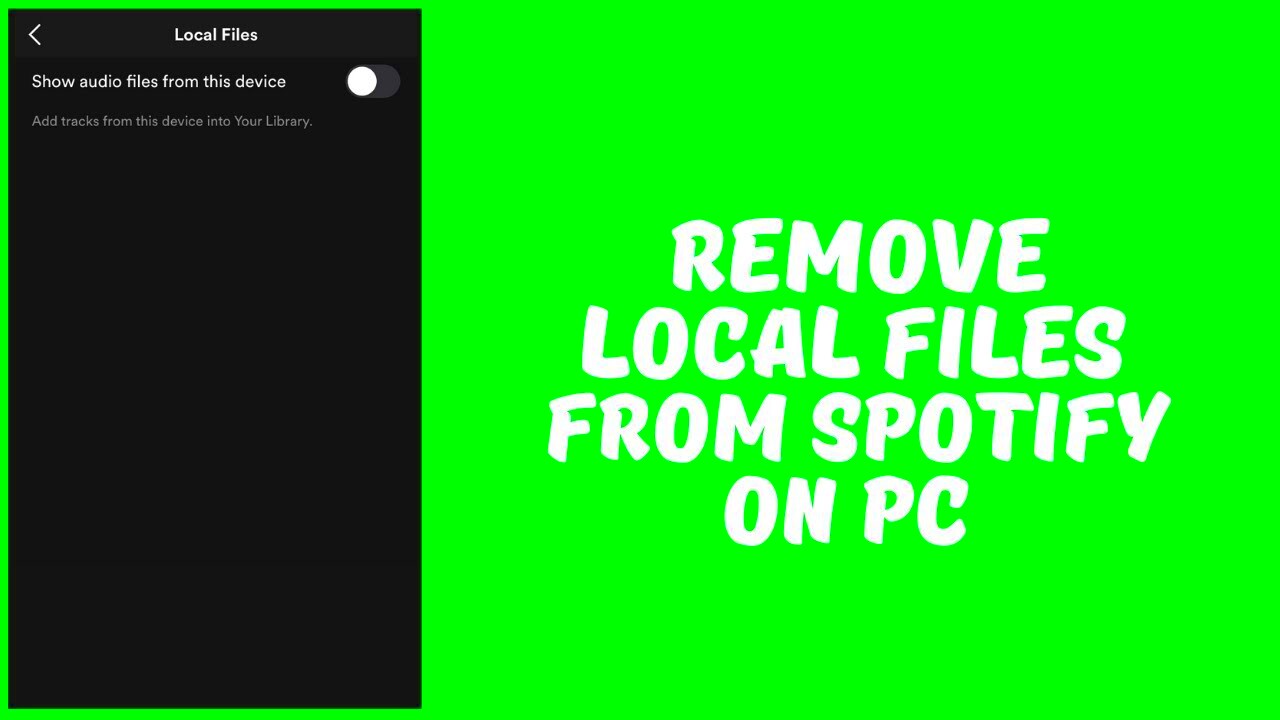Think of it as having too many bags of groceries stashed away in your room even though your fridge is already stocked. You wouldn't want them taking up space, would you? It's the same concept when it comes to files. After they've fulfilled their function it's wise to tidy them up. And let's be honest, having less mess on your phone or computer just gives you a feeling.
Why Deleting Local Files from Spotify is Important

Here’s why it matters:
- Free up space: Local files can take up a ton of storage without you realizing it.
- Smoother app performance: Fewer local files mean Spotify can run more efficiently, especially if you’re juggling multiple playlists.
- Device longevity: Reducing unnecessary data helps keep your phone or computer running smoothly for longer.
It’s similar to decluttering your closet. You dont need to get rid of all your songs but letting go of things you no longer use can feel rejuvenating.
How to Identify Local Files on Spotify
Spotify offers a function that allows you to view the files saved on your device. To access this feature, simply follow these instructions.
- Open Spotify and go to your library.
- Click on Settings (the gear icon).
- Scroll down to the Local Files section.
- You'll see an option to toggle "Show Local Files." Turn that on.
- Once activated, Spotify will display all your local files under a separate section in your library.
Here’s another handy piece of advice You can refine your search for files by utilizing the search bar. Simply enter the name of the song and if it’s saved on your device it will appear with a small label indicating so. It’s truly a breath of fresh air when you identify the files that are occupying your storage.It felt like stumbling upon a secret collection of vintage mixtapes – a blast from the past but not really essential to keep cluttering up my phone.
Step-by-Step Guide to Deleting Local Files from Spotify
Follow this easy guide to tidy up your local files.
- Open Spotify: First things first, launch the Spotify app on your device. It could be your phone or computer, depending on where you have local files stored.
- Head to Settings: In the top-right corner, click on the settings icon (the little gear). This is where all the magic happens.
- Locate the Local Files Section: Scroll down until you find a section labeled "Local Files." Here, you’ll see a toggle that lets you view these files in your library.
- Turn Off Local Files: If you don’t need local files anymore, simply turn off the toggle. This won’t delete the actual files from your device but will stop them from appearing in Spotify.
- Delete from Device: If you want to free up space, you’ll need to manually delete the local music files from your phone or computer’s storage.
It’s similar to tidying up a cluttered drawer. You have to put in the effort but once you’re finished it’s incredibly satisfying to reclaim that extra space. And no need to fret, the songs are still up for streaming so you won’t miss out on anything!
Alternative Methods for Freeing Up Space on Spotify
Clearing out files on your device can help free up some storage, but there are alternative approaches that could work better for you. I’ve experimented with various strategies to keep my
Spotify from taking up too much space and a few of them have made a significant difference.Here are a few alternatives you can try:
- Clear Spotify Cache: Over time, Spotify collects data that it stores on your device, which can really pile up. To clear the cache, go to Settings, then scroll down to Storage and click on Clear Cache. You’ll still have all your playlists, but the unnecessary data will be gone.
- Download Only Essential Playlists: Do you really need all 50 of your playlists available offline? Maybe not. You can manage which playlists are downloaded by toggling off the download button for the ones you don’t listen to frequently.
- Use Lower Quality Streaming: High-quality streaming uses more data and storage. If you’re tight on space, consider switching to a lower streaming quality in the Settings under Music Quality.
These approaches are akin to making incremental progress in tidying up your online presence. And the great news? You won’t need to give up on your beloved tunes – theyll remain intact just with better organization and taking up less room.
Common Mistakes to Avoid When Deleting Local Files
Ah, errors. We’ve all had our share of them haven’t we? I can’t count the times I’ve attempted to tidy things up only to accidentally get rid of something crucial—like that instance when I tried to declutter my phone and ended up erasing my beloved playlist. Ouch. However the silver lining is that you can steer clear of those hassles by following some simple advice.When it comes to removing files from your computer, there are a few common errors to be cautious of.
- Deleting the wrong files: It’s easy to get click-happy and delete songs you actually want to keep. Always double-check which files are local and which are streamed.
- Not backing up: If your local files are precious to you (think rare songs or personal recordings), make sure to back them up before deleting. You don’t want to lose them forever.
- Forgetting about other devices: If you use Spotify across multiple devices, remember that deleting local files on one device doesn’t mean they’re gone from others. You’ll need to repeat the process on each device.
- Assuming deleted means gone: Turning off the “Show Local Files” toggle in Spotify doesn’t actually delete the files from your device. You’ll need to manually go into your phone or computer’s storage to fully remove them.
The trick is to pace yourself and stay present in the moment. Believe me, when you get it spot on you’ll feel like a master at tidying up your digital space.
Frequently Asked Questions (FAQ)
Whenever I bring up the topic of tidying up
Spotify storage I tend to get the same questions. Its only natural since nobody wants to ruin their playlists or misplace their beloved songs. Allow me to address a few of the inquiries that I frequently encounter.
1. Will deleting local files affect my Spotify playlists?
Absolutely not! Deleting files won’t have any impact on your playlists. Local files are simply songs saved on your device. Even if you get rid of them the tracks from Spotifys streaming library will still be accessible. Your playlist remains unchanged except for the removal of files.
2. Can I recover local files after deleting them?
When you delete files from your device they are permanently unless you have a backup. If the files were part of your music library be sure to keep a copy stored elsewhere such as on an external drive or in cloud storage. I discovered this lesson the hard way when I misplaced a rare song by an old band. So remember to always create backups!
3. Is there a way to check how much space local files are using on Spotify?
Sadly,
Spotify lacks a feature that reveals the exact amount of space occupied by files. Nevertheless, you can take a look at your devices storage settings to determine the overall space used by the
Spotify app. If you find it to be quite sizable there’s a good chance that files are contributing to the issue.
4. Can I still access my local files on Spotify if I delete them from my device?
If you remove the files from your device they won't be available on
Spotify anymore. To use them again in the future you'll have to upload them. It's similar to deleting pictures from your phone once they're deleted they're gone unless you recover them.
5. What’s the difference between local files and downloaded songs on Spotify?
That’s an excellent inquiry Local files refer to music tracks that you’ve personally uploaded from your device to Spotify. On the hand downloaded songs are tracks that you’ve saved from Spotify to enjoy offline. While both consume storage they have distinct functions.
Conclusion: Keeping Your Spotify Storage Efficient
Ultimately managing your Spotify storage is akin to tidying up your living space—removing excess junk streamlines everything. Removing files may seem minor but it significantly impacts your devices performance. Whether you're sorting through documents adjusting app preferences or being more mindful of downloads these small actions will keep your Spotify in tip top shape. And believe me once you do it your phone will show its appreciation!
 Here’s why it matters:
Here’s why it matters:
 admin
admin








